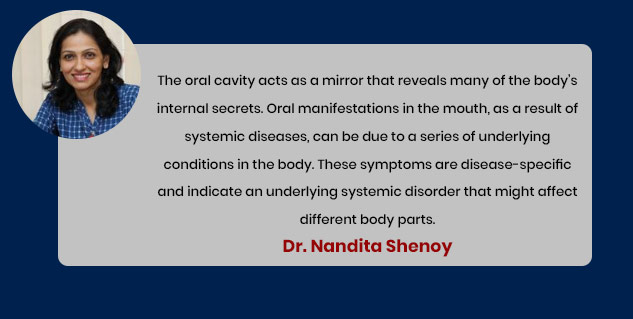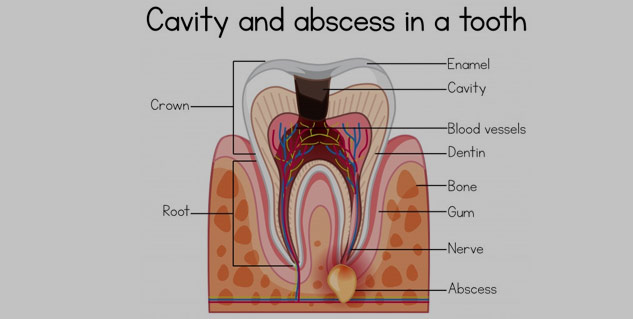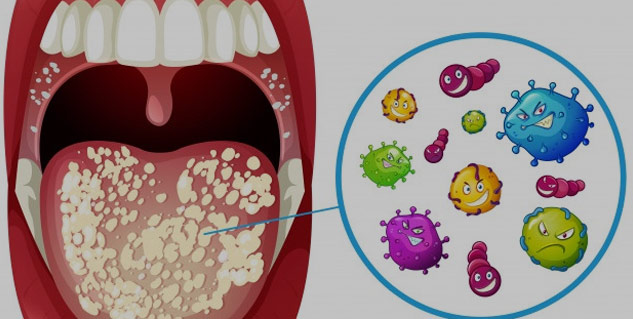
The oral cavity acts as a mirror that reveals many of the body’s internal secrets. Oral manifestations in the mouth, as a result of systemic diseases, can be due to a series of underlying conditions in the body. These symptoms are disease-specific and indicate an underlying systemic disorder that might affect different body parts. In this article, Dr. Nandita Shenoy, MDS, Associate Professor, Oral Medicine and Radiology, Manipal College of Dental Sciences, Mangalore, Manipal Academy of Higher Education explains different disorders and their oral symptoms.
Table of Content:-
The mouth is a gateway to the body, which fights disease-causing organisms from entering into our system. At the same, it also acts as a portal of entry for these microbes. If you see any symptoms on the oral mucosa, tongue, gums, dentition, periodontium, salivary glands, facial skeleton, lips, and palate, you must seek medical advice as these can be indicative of an underlying condition. It has been found in some cases, that these oral and oral cavity related symptoms were the only visible signs for particular diseases.
How dental health affects overall health?
There are many diseases whose symptoms start from the mouth. For example, Koplik’s spots or tiny spots that appear in the mouth are the initial symptoms of measles. Similarly, cracks/cuts near the angle of lips can be a sign of diabetes, and a malar or butterfly rash on the face is a symptom of lupus erythematosus, an autoimmune disorder, that affects the immune system of an individual. Other conditions that affect oral health are:
- HIV/AIDS (mucosal lesions)
- Osteoporosis (tooth loss and impact on jawbone)
Also Read: Know 5 Most Common Dental Issues & How To Tackle Them From Expert

Oral Manifestations of Disorders
Here are the oral signs and symptoms of a few disorders:
Blood disorders
Oral disorder symptoms could be indicative of Blood issues. Acute leukaemias tend to produce a characteristic enlargement of gums (gingival hypertrophy) and spontaneous gum bleeding that signifies a lot about the progression of the disease. Spontaneous bleeds in the oral cavity and accumulation of blood in tissues may be seen in thrombocytopenia (reduced platelet count). Paleness of the oral mucosa, loss of lingual papillae (small structures on the surface of the tongue), ulcers in the corner of the mouth, and nonspecific complaints like burning sensation are commonly seen in iron deficiency disorders like anaemia.

Gastrointestinal disorders
In gastrointestinal diseases (GI diseases), oral lesions have an important role. Patients suffering from these diseases often present with diffuse swelling and angular inflammation of the lips , hyperplastic rigid mucosa giving a cobblestone appearance to the buccal mucosa (lining of the cheeks and lips)
Renal disorders
Uremic stomatitis (a rare mucosal disorder) and uremic breath (urine like breath) are typical features of undiagnosed chronic kidney disease (CKD). In CKD, painful ulcers in mouth and white patches are seen on the buccal mucosa, dorsum of the tongue, and floor of the mouth.

Cardiovascular disorders
Medications employed to treat hypertension have various oral manifestations like gingival (gum related) overgrowth and periodontal issues that may require the physician’s consultation to change the regimen. Diuretics (pills for increased production of urie) when prescribed cause oral dryness, burning mouth, and ulcerations which affects the quality of life for such patients.
Also Read: Mouth Ulcers in Children: Know Causes, Treatment and Prevention
Psychiatric Disorders
Psychiatric disorders among youngsters like anorexia & bulimia nervosa are the first to bring changes in the oral cavity. The dental surgeon is the best medical expert and probably the first one to assess the physical and the oral effects of these conditions based on symptoms like dental erosions secondary to dry mouth and physical trauma, oral ulcers, and ulcerations in the pharynx.
Oral manifestations of diabetes mellitus

The most common changes in the oral cavity seen in diabetes are dry mouth, burning mouth syndrome, increased reactivity to local irritation, multiple periodontal abscesses, delayed wound healing, and recurrent infections. Gum abscess and oral dryness are the regular presentations in undiagnosed diabetics, and periodontitis is considered the sixth important complication of diabetes.
Skin disorders
Several dermatological disorders tend to have preexisting oral manifestations. Moreover, these oral changes can hint at the systemic disorders, lying beneath giving the clinician a clear idea about the disease.
Oral changes in any systemic illness are significant factors for the clinician to arrive at a diagnosis and plan the course of treatment. Dental surgeons, especially, must be equipped with knowledge about various systemic disorders and their oral manifestations. The mouth is considered as the most accessible window for early and convenient examination of signs and symptoms of many systemic diseases which should never be neglected by you and any treating physicians.
Image Credits- freepik
Also watch this video
How we keep this article up to date:
We work with experts and keep a close eye on the latest in health and wellness. Whenever there is a new research or helpful information, we update our articles with accurate and useful advice.
Current Version